HI-6026 Audit, Assurance and Services: Tutorial Questions Analysis
VerifiedAdded on 2023/01/06
|11
|3212
|48
Homework Assignment
AI Summary
This assignment analyzes key concepts in audit, assurance, and services, addressing tutorial questions related to reasonable assurance, professional skepticism, ethical considerations, materiality, and going concern assumptions. The assignment begins with a letter explaining reasonable assurance and professional skepticism. It then examines an ethical dilemma related to late payments and proposes solutions. The determination of materiality and its impact on auditor judgment are discussed, along with the auditor's responsibilities regarding going concern assumptions. The assignment identifies significant events and conditions affecting a company's ability to continue as a going concern and justifies the events and accounting treatment. Finally, the assignment concludes by identifying the appropriate type of audit opinion to be issued. The analysis covers the various aspects of audit and auditors and how they perform in an organization related to each event, ensuring that financial records are true and fair and activities are performed under the compliances of law and standards.
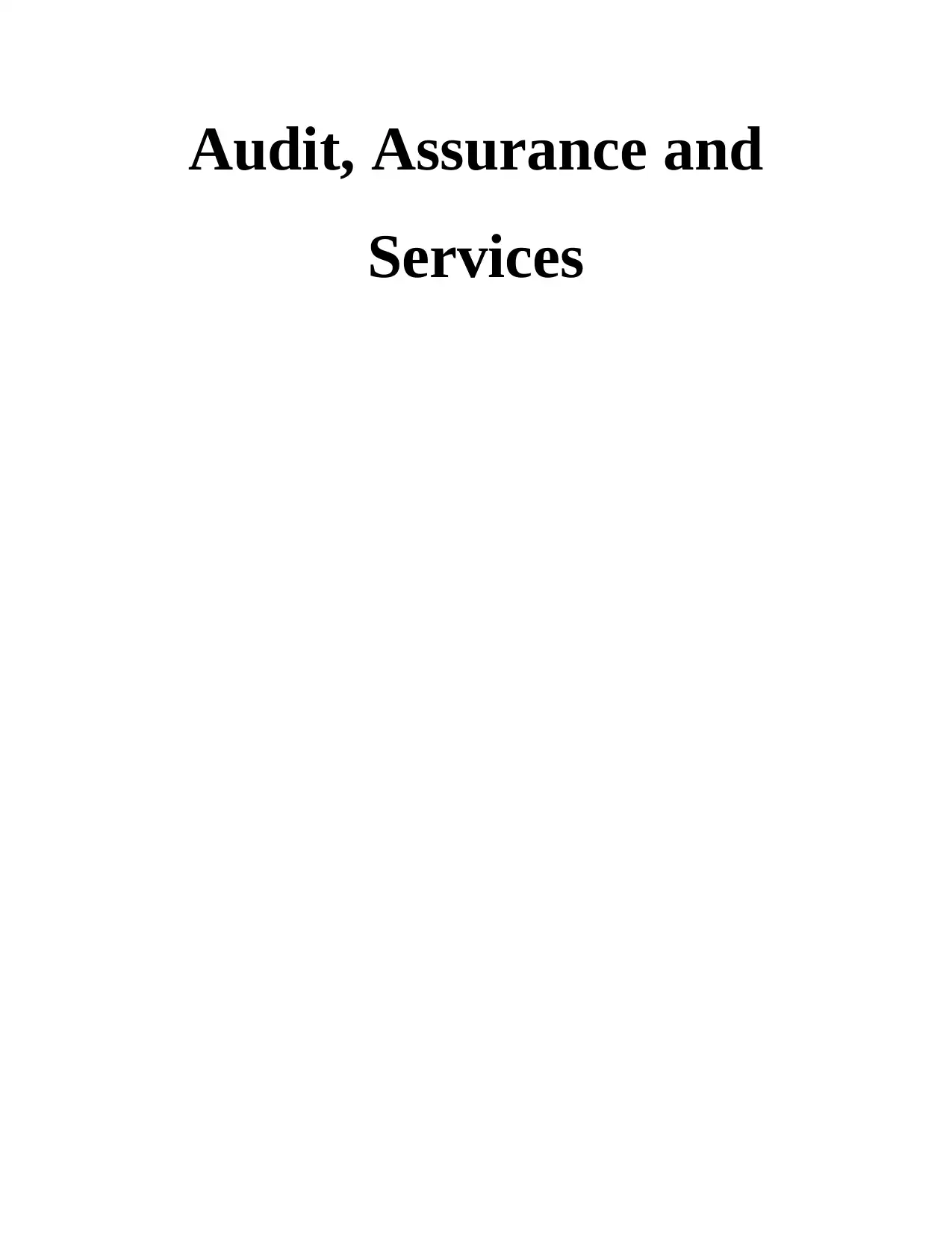
Audit, Assurance and
Services
Services
Secure Best Marks with AI Grader
Need help grading? Try our AI Grader for instant feedback on your assignments.
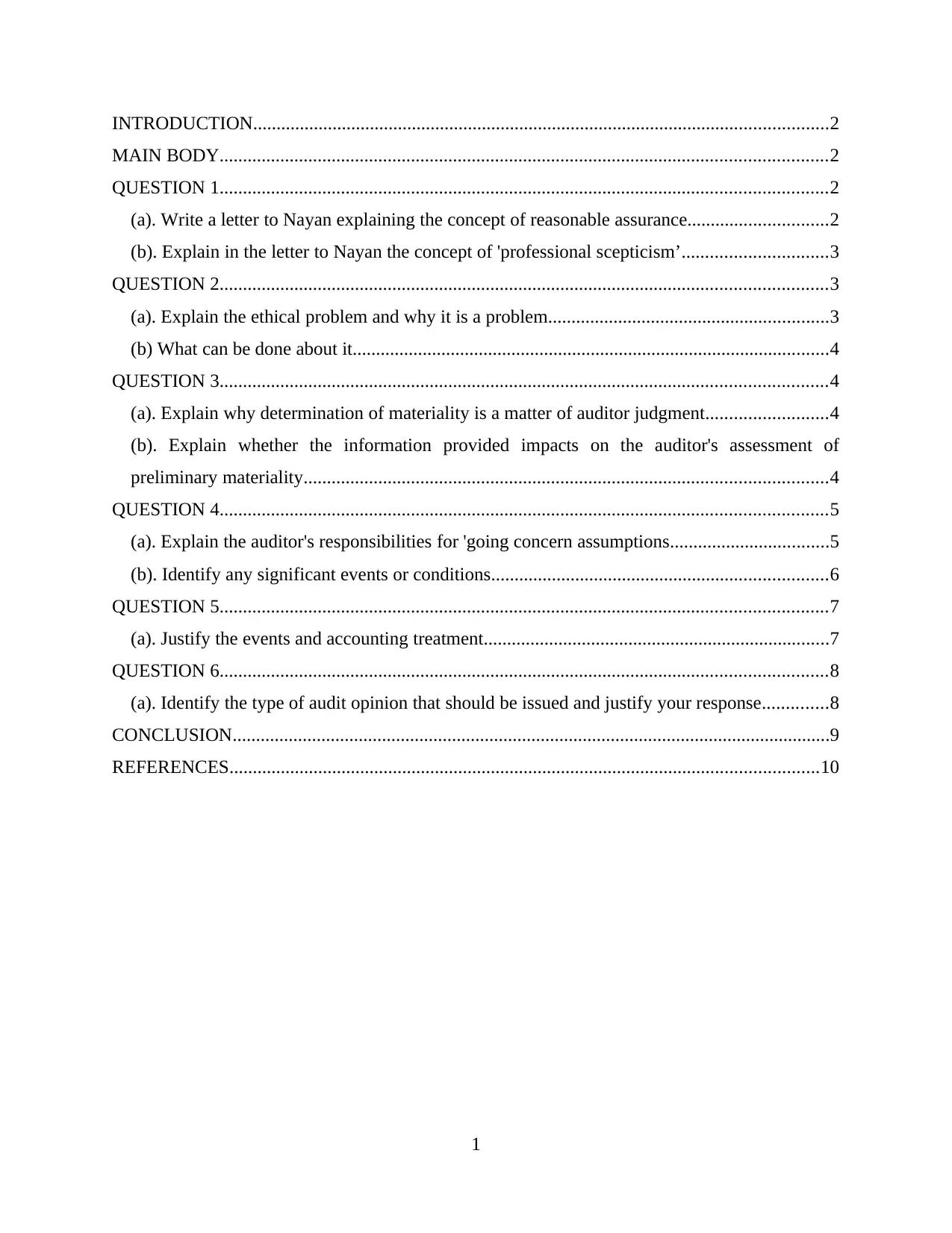
INTRODUCTION...........................................................................................................................2
MAIN BODY..................................................................................................................................2
QUESTION 1..................................................................................................................................2
(a). Write a letter to Nayan explaining the concept of reasonable assurance..............................2
(b). Explain in the letter to Nayan the concept of 'professional scepticism’...............................3
QUESTION 2..................................................................................................................................3
(a). Explain the ethical problem and why it is a problem............................................................3
(b) What can be done about it......................................................................................................4
QUESTION 3..................................................................................................................................4
(a). Explain why determination of materiality is a matter of auditor judgment..........................4
(b). Explain whether the information provided impacts on the auditor's assessment of
preliminary materiality................................................................................................................4
QUESTION 4..................................................................................................................................5
(a). Explain the auditor's responsibilities for 'going concern assumptions..................................5
(b). Identify any significant events or conditions........................................................................6
QUESTION 5..................................................................................................................................7
(a). Justify the events and accounting treatment..........................................................................7
QUESTION 6..................................................................................................................................8
(a). Identify the type of audit opinion that should be issued and justify your response..............8
CONCLUSION................................................................................................................................9
REFERENCES..............................................................................................................................10
1
MAIN BODY..................................................................................................................................2
QUESTION 1..................................................................................................................................2
(a). Write a letter to Nayan explaining the concept of reasonable assurance..............................2
(b). Explain in the letter to Nayan the concept of 'professional scepticism’...............................3
QUESTION 2..................................................................................................................................3
(a). Explain the ethical problem and why it is a problem............................................................3
(b) What can be done about it......................................................................................................4
QUESTION 3..................................................................................................................................4
(a). Explain why determination of materiality is a matter of auditor judgment..........................4
(b). Explain whether the information provided impacts on the auditor's assessment of
preliminary materiality................................................................................................................4
QUESTION 4..................................................................................................................................5
(a). Explain the auditor's responsibilities for 'going concern assumptions..................................5
(b). Identify any significant events or conditions........................................................................6
QUESTION 5..................................................................................................................................7
(a). Justify the events and accounting treatment..........................................................................7
QUESTION 6..................................................................................................................................8
(a). Identify the type of audit opinion that should be issued and justify your response..............8
CONCLUSION................................................................................................................................9
REFERENCES..............................................................................................................................10
1
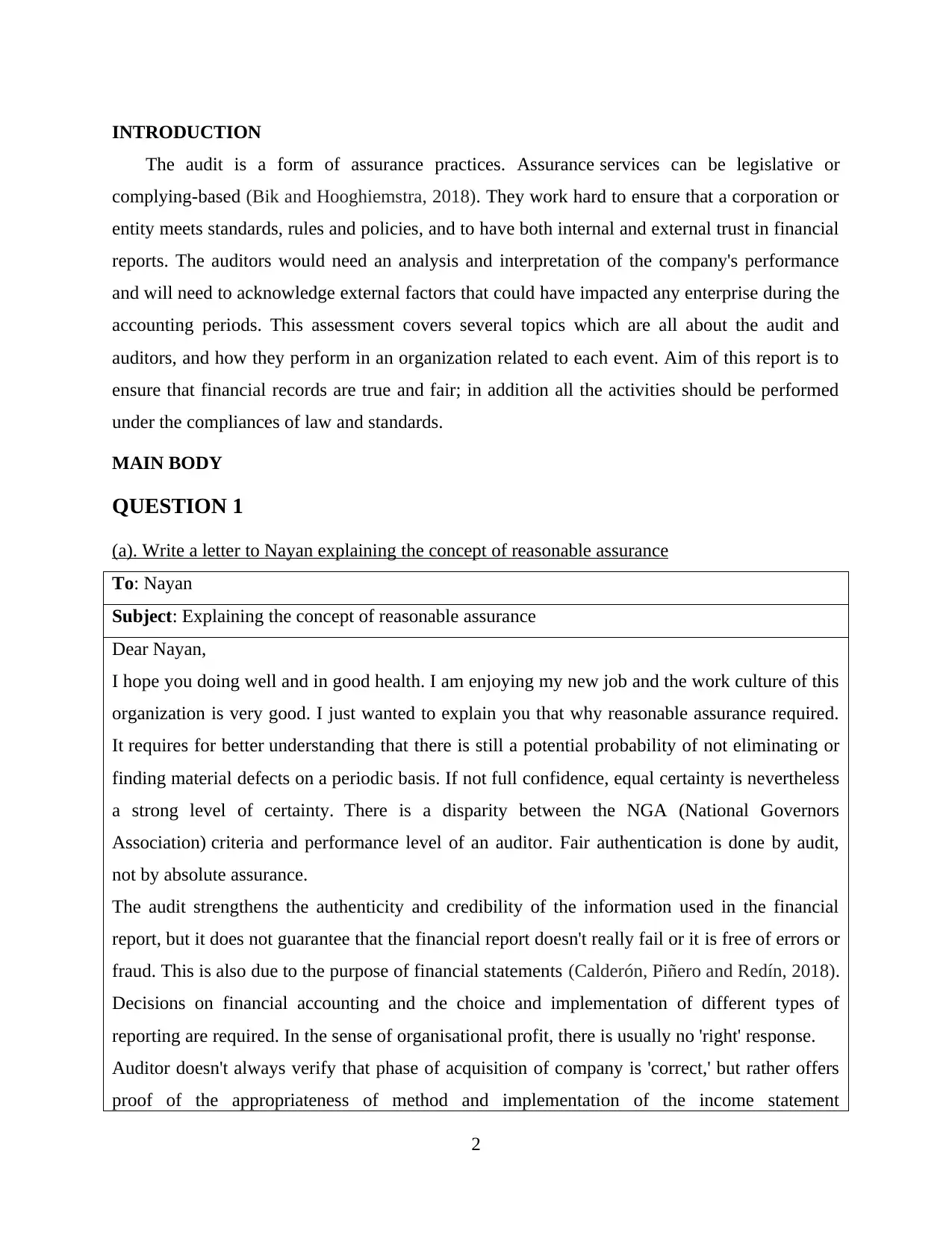
INTRODUCTION
The audit is a form of assurance practices. Assurance services can be legislative or
complying-based (Bik and Hooghiemstra, 2018). They work hard to ensure that a corporation or
entity meets standards, rules and policies, and to have both internal and external trust in financial
reports. The auditors would need an analysis and interpretation of the company's performance
and will need to acknowledge external factors that could have impacted any enterprise during the
accounting periods. This assessment covers several topics which are all about the audit and
auditors, and how they perform in an organization related to each event. Aim of this report is to
ensure that financial records are true and fair; in addition all the activities should be performed
under the compliances of law and standards.
MAIN BODY
QUESTION 1
(a). Write a letter to Nayan explaining the concept of reasonable assurance
To: Nayan
Subject: Explaining the concept of reasonable assurance
Dear Nayan,
I hope you doing well and in good health. I am enjoying my new job and the work culture of this
organization is very good. I just wanted to explain you that why reasonable assurance required.
It requires for better understanding that there is still a potential probability of not eliminating or
finding material defects on a periodic basis. If not full confidence, equal certainty is nevertheless
a strong level of certainty. There is a disparity between the NGA (National Governors
Association) criteria and performance level of an auditor. Fair authentication is done by audit,
not by absolute assurance.
The audit strengthens the authenticity and credibility of the information used in the financial
report, but it does not guarantee that the financial report doesn't really fail or it is free of errors or
fraud. This is also due to the purpose of financial statements (Calderón, Piñero and Redín, 2018).
Decisions on financial accounting and the choice and implementation of different types of
reporting are required. In the sense of organisational profit, there is usually no 'right' response.
Auditor doesn't always verify that phase of acquisition of company is 'correct,' but rather offers
proof of the appropriateness of method and implementation of the income statement
2
The audit is a form of assurance practices. Assurance services can be legislative or
complying-based (Bik and Hooghiemstra, 2018). They work hard to ensure that a corporation or
entity meets standards, rules and policies, and to have both internal and external trust in financial
reports. The auditors would need an analysis and interpretation of the company's performance
and will need to acknowledge external factors that could have impacted any enterprise during the
accounting periods. This assessment covers several topics which are all about the audit and
auditors, and how they perform in an organization related to each event. Aim of this report is to
ensure that financial records are true and fair; in addition all the activities should be performed
under the compliances of law and standards.
MAIN BODY
QUESTION 1
(a). Write a letter to Nayan explaining the concept of reasonable assurance
To: Nayan
Subject: Explaining the concept of reasonable assurance
Dear Nayan,
I hope you doing well and in good health. I am enjoying my new job and the work culture of this
organization is very good. I just wanted to explain you that why reasonable assurance required.
It requires for better understanding that there is still a potential probability of not eliminating or
finding material defects on a periodic basis. If not full confidence, equal certainty is nevertheless
a strong level of certainty. There is a disparity between the NGA (National Governors
Association) criteria and performance level of an auditor. Fair authentication is done by audit,
not by absolute assurance.
The audit strengthens the authenticity and credibility of the information used in the financial
report, but it does not guarantee that the financial report doesn't really fail or it is free of errors or
fraud. This is also due to the purpose of financial statements (Calderón, Piñero and Redín, 2018).
Decisions on financial accounting and the choice and implementation of different types of
reporting are required. In the sense of organisational profit, there is usually no 'right' response.
Auditor doesn't always verify that phase of acquisition of company is 'correct,' but rather offers
proof of the appropriateness of method and implementation of the income statement
2
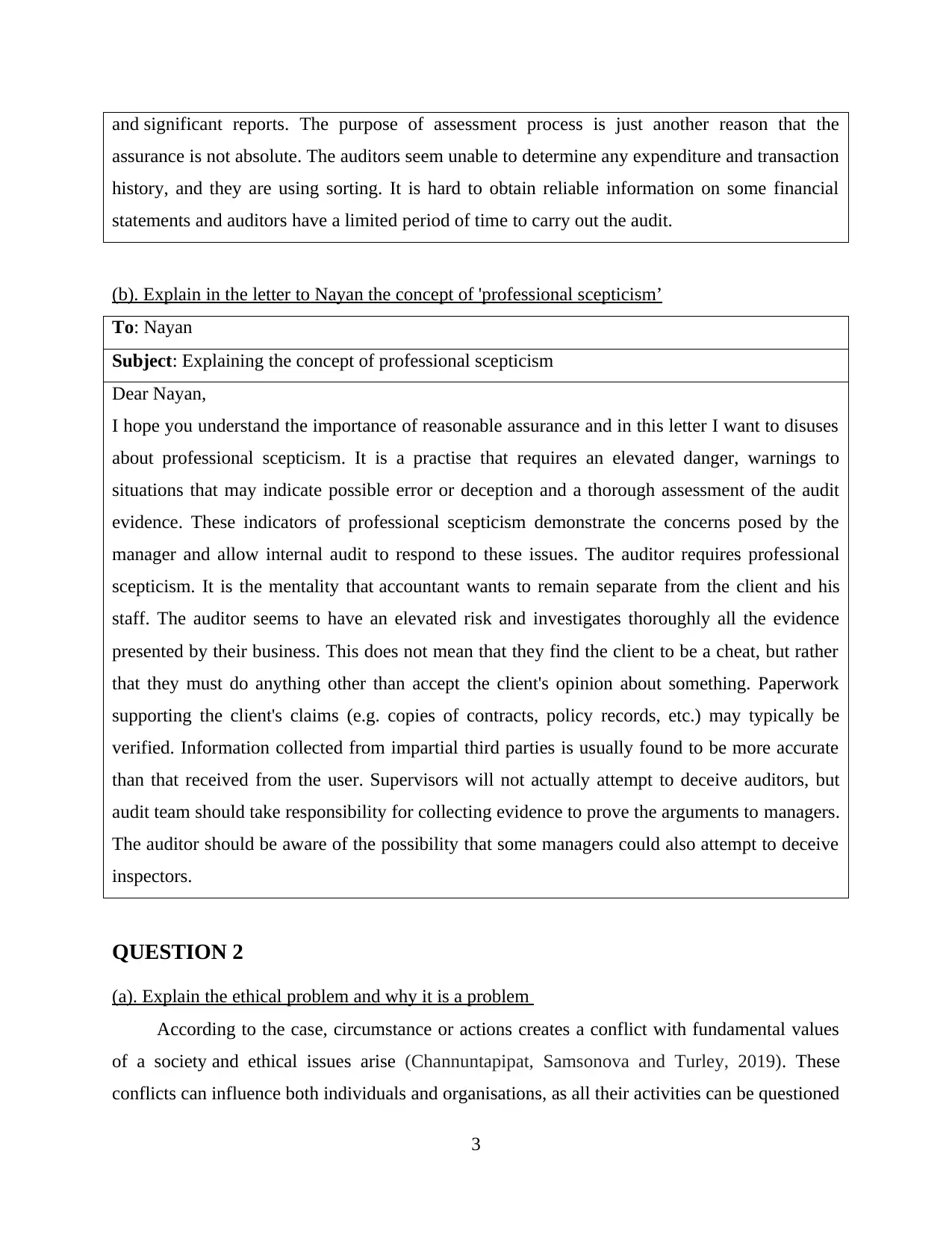
and significant reports. The purpose of assessment process is just another reason that the
assurance is not absolute. The auditors seem unable to determine any expenditure and transaction
history, and they are using sorting. It is hard to obtain reliable information on some financial
statements and auditors have a limited period of time to carry out the audit.
(b). Explain in the letter to Nayan the concept of 'professional scepticism’
To: Nayan
Subject: Explaining the concept of professional scepticism
Dear Nayan,
I hope you understand the importance of reasonable assurance and in this letter I want to disuses
about professional scepticism. It is a practise that requires an elevated danger, warnings to
situations that may indicate possible error or deception and a thorough assessment of the audit
evidence. These indicators of professional scepticism demonstrate the concerns posed by the
manager and allow internal audit to respond to these issues. The auditor requires professional
scepticism. It is the mentality that accountant wants to remain separate from the client and his
staff. The auditor seems to have an elevated risk and investigates thoroughly all the evidence
presented by their business. This does not mean that they find the client to be a cheat, but rather
that they must do anything other than accept the client's opinion about something. Paperwork
supporting the client's claims (e.g. copies of contracts, policy records, etc.) may typically be
verified. Information collected from impartial third parties is usually found to be more accurate
than that received from the user. Supervisors will not actually attempt to deceive auditors, but
audit team should take responsibility for collecting evidence to prove the arguments to managers.
The auditor should be aware of the possibility that some managers could also attempt to deceive
inspectors.
QUESTION 2
(a). Explain the ethical problem and why it is a problem
According to the case, circumstance or actions creates a conflict with fundamental values
of a society and ethical issues arise (Channuntapipat, Samsonova and Turley, 2019). These
conflicts can influence both individuals and organisations, as all their activities can be questioned
3
assurance is not absolute. The auditors seem unable to determine any expenditure and transaction
history, and they are using sorting. It is hard to obtain reliable information on some financial
statements and auditors have a limited period of time to carry out the audit.
(b). Explain in the letter to Nayan the concept of 'professional scepticism’
To: Nayan
Subject: Explaining the concept of professional scepticism
Dear Nayan,
I hope you understand the importance of reasonable assurance and in this letter I want to disuses
about professional scepticism. It is a practise that requires an elevated danger, warnings to
situations that may indicate possible error or deception and a thorough assessment of the audit
evidence. These indicators of professional scepticism demonstrate the concerns posed by the
manager and allow internal audit to respond to these issues. The auditor requires professional
scepticism. It is the mentality that accountant wants to remain separate from the client and his
staff. The auditor seems to have an elevated risk and investigates thoroughly all the evidence
presented by their business. This does not mean that they find the client to be a cheat, but rather
that they must do anything other than accept the client's opinion about something. Paperwork
supporting the client's claims (e.g. copies of contracts, policy records, etc.) may typically be
verified. Information collected from impartial third parties is usually found to be more accurate
than that received from the user. Supervisors will not actually attempt to deceive auditors, but
audit team should take responsibility for collecting evidence to prove the arguments to managers.
The auditor should be aware of the possibility that some managers could also attempt to deceive
inspectors.
QUESTION 2
(a). Explain the ethical problem and why it is a problem
According to the case, circumstance or actions creates a conflict with fundamental values
of a society and ethical issues arise (Channuntapipat, Samsonova and Turley, 2019). These
conflicts can influence both individuals and organisations, as all their activities can be questioned
3
Secure Best Marks with AI Grader
Need help grading? Try our AI Grader for instant feedback on your assignments.
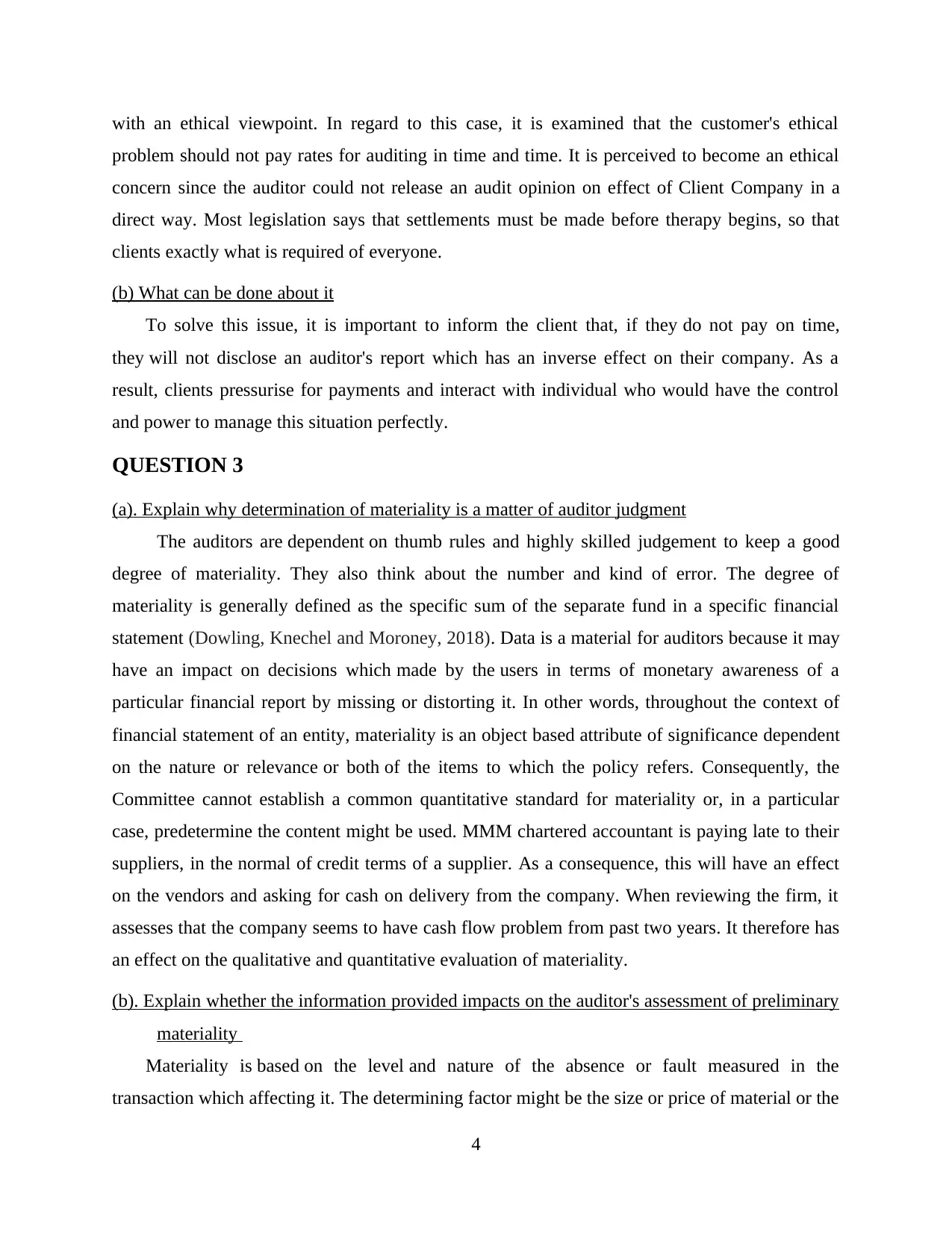
with an ethical viewpoint. In regard to this case, it is examined that the customer's ethical
problem should not pay rates for auditing in time and time. It is perceived to become an ethical
concern since the auditor could not release an audit opinion on effect of Client Company in a
direct way. Most legislation says that settlements must be made before therapy begins, so that
clients exactly what is required of everyone.
(b) What can be done about it
To solve this issue, it is important to inform the client that, if they do not pay on time,
they will not disclose an auditor's report which has an inverse effect on their company. As a
result, clients pressurise for payments and interact with individual who would have the control
and power to manage this situation perfectly.
QUESTION 3
(a). Explain why determination of materiality is a matter of auditor judgment
The auditors are dependent on thumb rules and highly skilled judgement to keep a good
degree of materiality. They also think about the number and kind of error. The degree of
materiality is generally defined as the specific sum of the separate fund in a specific financial
statement (Dowling, Knechel and Moroney, 2018). Data is a material for auditors because it may
have an impact on decisions which made by the users in terms of monetary awareness of a
particular financial report by missing or distorting it. In other words, throughout the context of
financial statement of an entity, materiality is an object based attribute of significance dependent
on the nature or relevance or both of the items to which the policy refers. Consequently, the
Committee cannot establish a common quantitative standard for materiality or, in a particular
case, predetermine the content might be used. MMM chartered accountant is paying late to their
suppliers, in the normal of credit terms of a supplier. As a consequence, this will have an effect
on the vendors and asking for cash on delivery from the company. When reviewing the firm, it
assesses that the company seems to have cash flow problem from past two years. It therefore has
an effect on the qualitative and quantitative evaluation of materiality.
(b). Explain whether the information provided impacts on the auditor's assessment of preliminary
materiality
Materiality is based on the level and nature of the absence or fault measured in the
transaction which affecting it. The determining factor might be the size or price of material or the
4
problem should not pay rates for auditing in time and time. It is perceived to become an ethical
concern since the auditor could not release an audit opinion on effect of Client Company in a
direct way. Most legislation says that settlements must be made before therapy begins, so that
clients exactly what is required of everyone.
(b) What can be done about it
To solve this issue, it is important to inform the client that, if they do not pay on time,
they will not disclose an auditor's report which has an inverse effect on their company. As a
result, clients pressurise for payments and interact with individual who would have the control
and power to manage this situation perfectly.
QUESTION 3
(a). Explain why determination of materiality is a matter of auditor judgment
The auditors are dependent on thumb rules and highly skilled judgement to keep a good
degree of materiality. They also think about the number and kind of error. The degree of
materiality is generally defined as the specific sum of the separate fund in a specific financial
statement (Dowling, Knechel and Moroney, 2018). Data is a material for auditors because it may
have an impact on decisions which made by the users in terms of monetary awareness of a
particular financial report by missing or distorting it. In other words, throughout the context of
financial statement of an entity, materiality is an object based attribute of significance dependent
on the nature or relevance or both of the items to which the policy refers. Consequently, the
Committee cannot establish a common quantitative standard for materiality or, in a particular
case, predetermine the content might be used. MMM chartered accountant is paying late to their
suppliers, in the normal of credit terms of a supplier. As a consequence, this will have an effect
on the vendors and asking for cash on delivery from the company. When reviewing the firm, it
assesses that the company seems to have cash flow problem from past two years. It therefore has
an effect on the qualitative and quantitative evaluation of materiality.
(b). Explain whether the information provided impacts on the auditor's assessment of preliminary
materiality
Materiality is based on the level and nature of the absence or fault measured in the
transaction which affecting it. The determining factor might be the size or price of material or the
4
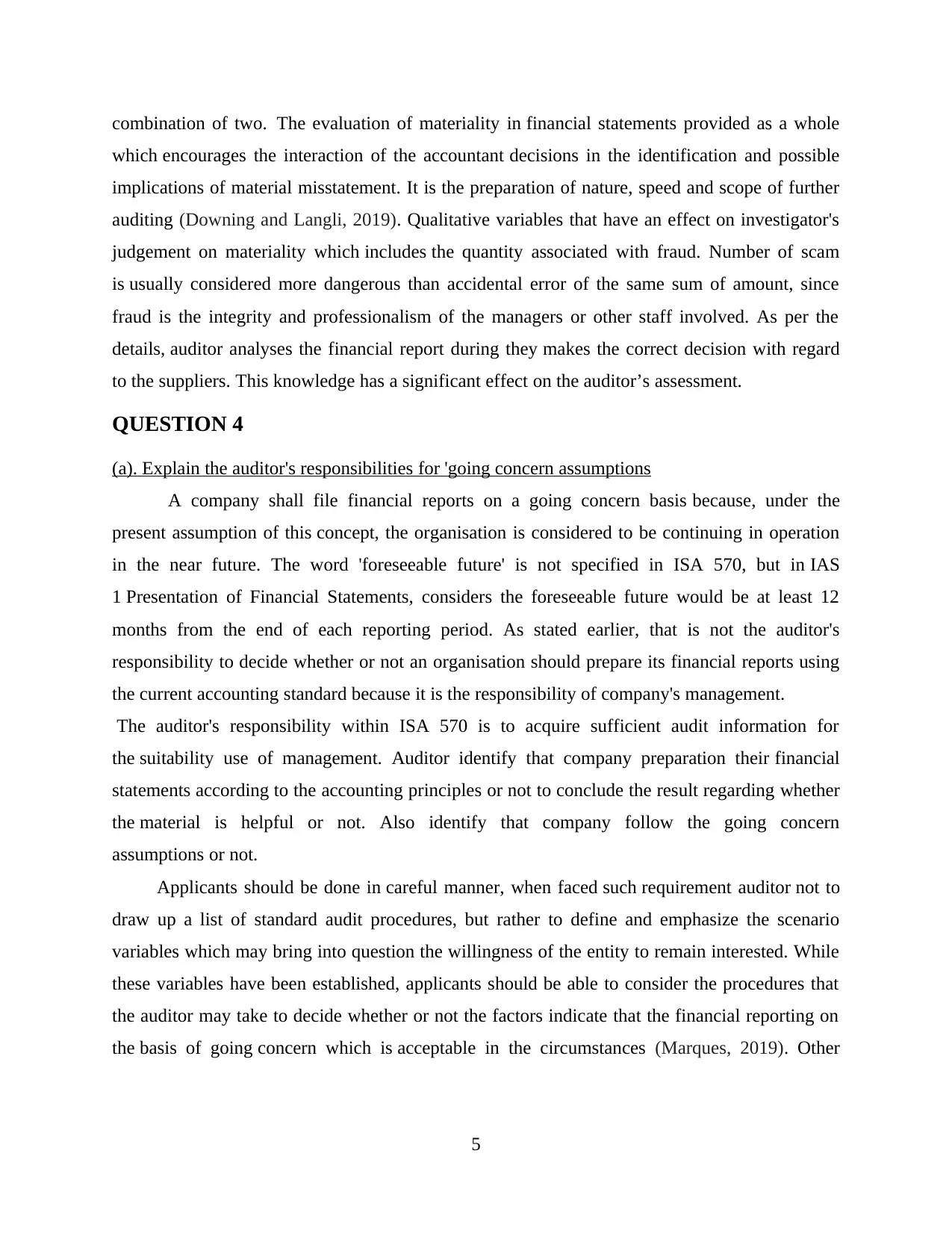
combination of two. The evaluation of materiality in financial statements provided as a whole
which encourages the interaction of the accountant decisions in the identification and possible
implications of material misstatement. It is the preparation of nature, speed and scope of further
auditing (Downing and Langli, 2019). Qualitative variables that have an effect on investigator's
judgement on materiality which includes the quantity associated with fraud. Number of scam
is usually considered more dangerous than accidental error of the same sum of amount, since
fraud is the integrity and professionalism of the managers or other staff involved. As per the
details, auditor analyses the financial report during they makes the correct decision with regard
to the suppliers. This knowledge has a significant effect on the auditor’s assessment.
QUESTION 4
(a). Explain the auditor's responsibilities for 'going concern assumptions
A company shall file financial reports on a going concern basis because, under the
present assumption of this concept, the organisation is considered to be continuing in operation
in the near future. The word 'foreseeable future' is not specified in ISA 570, but in IAS
1 Presentation of Financial Statements, considers the foreseeable future would be at least 12
months from the end of each reporting period. As stated earlier, that is not the auditor's
responsibility to decide whether or not an organisation should prepare its financial reports using
the current accounting standard because it is the responsibility of company's management.
The auditor's responsibility within ISA 570 is to acquire sufficient audit information for
the suitability use of management. Auditor identify that company preparation their financial
statements according to the accounting principles or not to conclude the result regarding whether
the material is helpful or not. Also identify that company follow the going concern
assumptions or not.
Applicants should be done in careful manner, when faced such requirement auditor not to
draw up a list of standard audit procedures, but rather to define and emphasize the scenario
variables which may bring into question the willingness of the entity to remain interested. While
these variables have been established, applicants should be able to consider the procedures that
the auditor may take to decide whether or not the factors indicate that the financial reporting on
the basis of going concern which is acceptable in the circumstances (Marques, 2019). Other
5
which encourages the interaction of the accountant decisions in the identification and possible
implications of material misstatement. It is the preparation of nature, speed and scope of further
auditing (Downing and Langli, 2019). Qualitative variables that have an effect on investigator's
judgement on materiality which includes the quantity associated with fraud. Number of scam
is usually considered more dangerous than accidental error of the same sum of amount, since
fraud is the integrity and professionalism of the managers or other staff involved. As per the
details, auditor analyses the financial report during they makes the correct decision with regard
to the suppliers. This knowledge has a significant effect on the auditor’s assessment.
QUESTION 4
(a). Explain the auditor's responsibilities for 'going concern assumptions
A company shall file financial reports on a going concern basis because, under the
present assumption of this concept, the organisation is considered to be continuing in operation
in the near future. The word 'foreseeable future' is not specified in ISA 570, but in IAS
1 Presentation of Financial Statements, considers the foreseeable future would be at least 12
months from the end of each reporting period. As stated earlier, that is not the auditor's
responsibility to decide whether or not an organisation should prepare its financial reports using
the current accounting standard because it is the responsibility of company's management.
The auditor's responsibility within ISA 570 is to acquire sufficient audit information for
the suitability use of management. Auditor identify that company preparation their financial
statements according to the accounting principles or not to conclude the result regarding whether
the material is helpful or not. Also identify that company follow the going concern
assumptions or not.
Applicants should be done in careful manner, when faced such requirement auditor not to
draw up a list of standard audit procedures, but rather to define and emphasize the scenario
variables which may bring into question the willingness of the entity to remain interested. While
these variables have been established, applicants should be able to consider the procedures that
the auditor may take to decide whether or not the factors indicate that the financial reporting on
the basis of going concern which is acceptable in the circumstances (Marques, 2019). Other
5
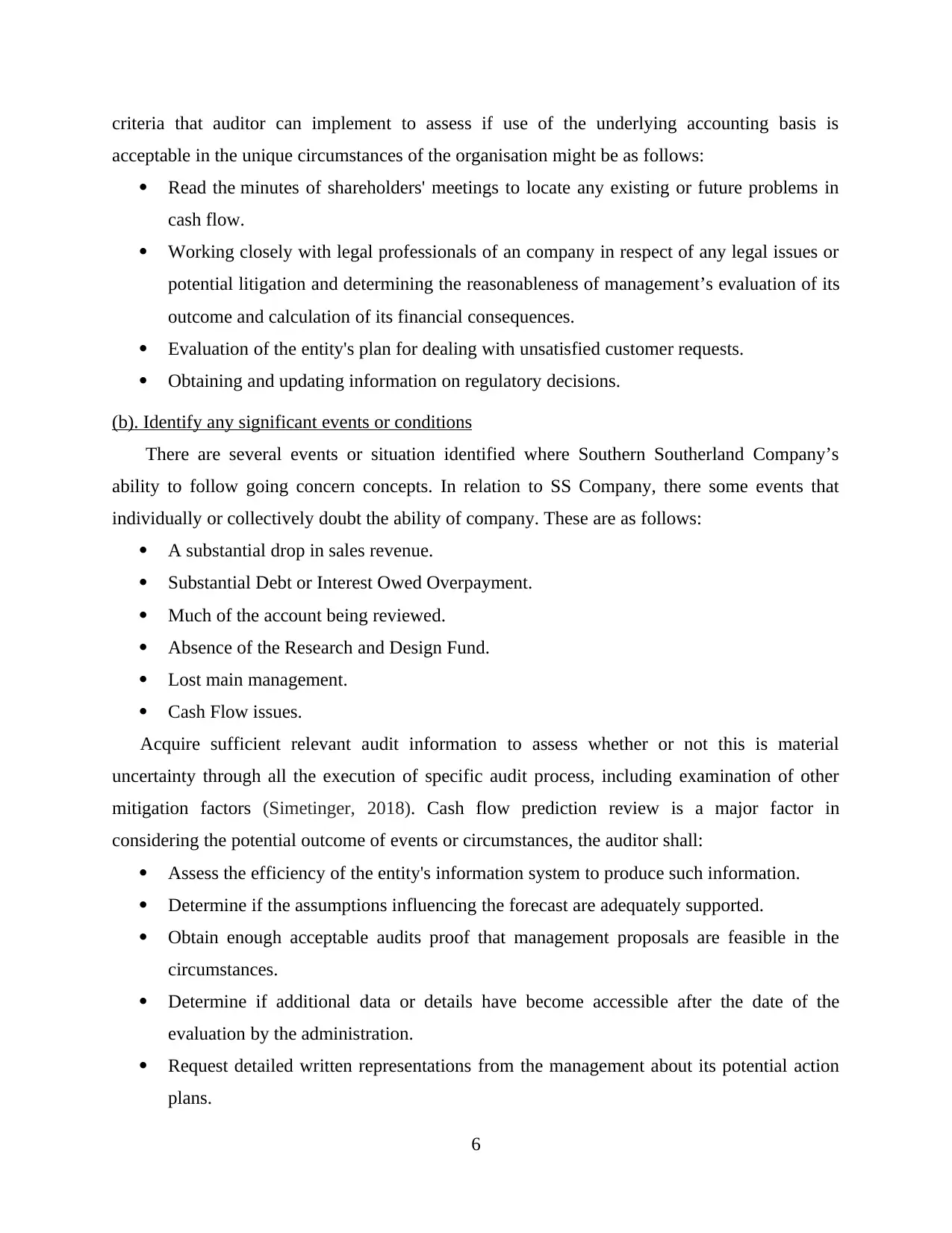
criteria that auditor can implement to assess if use of the underlying accounting basis is
acceptable in the unique circumstances of the organisation might be as follows:
Read the minutes of shareholders' meetings to locate any existing or future problems in
cash flow.
Working closely with legal professionals of an company in respect of any legal issues or
potential litigation and determining the reasonableness of management’s evaluation of its
outcome and calculation of its financial consequences.
Evaluation of the entity's plan for dealing with unsatisfied customer requests.
Obtaining and updating information on regulatory decisions.
(b). Identify any significant events or conditions
There are several events or situation identified where Southern Southerland Company’s
ability to follow going concern concepts. In relation to SS Company, there some events that
individually or collectively doubt the ability of company. These are as follows:
A substantial drop in sales revenue.
Substantial Debt or Interest Owed Overpayment.
Much of the account being reviewed.
Absence of the Research and Design Fund.
Lost main management.
Cash Flow issues.
Acquire sufficient relevant audit information to assess whether or not this is material
uncertainty through all the execution of specific audit process, including examination of other
mitigation factors (Simetinger, 2018). Cash flow prediction review is a major factor in
considering the potential outcome of events or circumstances, the auditor shall:
Assess the efficiency of the entity's information system to produce such information.
Determine if the assumptions influencing the forecast are adequately supported.
Obtain enough acceptable audits proof that management proposals are feasible in the
circumstances.
Determine if additional data or details have become accessible after the date of the
evaluation by the administration.
Request detailed written representations from the management about its potential action
plans.
6
acceptable in the unique circumstances of the organisation might be as follows:
Read the minutes of shareholders' meetings to locate any existing or future problems in
cash flow.
Working closely with legal professionals of an company in respect of any legal issues or
potential litigation and determining the reasonableness of management’s evaluation of its
outcome and calculation of its financial consequences.
Evaluation of the entity's plan for dealing with unsatisfied customer requests.
Obtaining and updating information on regulatory decisions.
(b). Identify any significant events or conditions
There are several events or situation identified where Southern Southerland Company’s
ability to follow going concern concepts. In relation to SS Company, there some events that
individually or collectively doubt the ability of company. These are as follows:
A substantial drop in sales revenue.
Substantial Debt or Interest Owed Overpayment.
Much of the account being reviewed.
Absence of the Research and Design Fund.
Lost main management.
Cash Flow issues.
Acquire sufficient relevant audit information to assess whether or not this is material
uncertainty through all the execution of specific audit process, including examination of other
mitigation factors (Simetinger, 2018). Cash flow prediction review is a major factor in
considering the potential outcome of events or circumstances, the auditor shall:
Assess the efficiency of the entity's information system to produce such information.
Determine if the assumptions influencing the forecast are adequately supported.
Obtain enough acceptable audits proof that management proposals are feasible in the
circumstances.
Determine if additional data or details have become accessible after the date of the
evaluation by the administration.
Request detailed written representations from the management about its potential action
plans.
6
Paraphrase This Document
Need a fresh take? Get an instant paraphrase of this document with our AI Paraphraser
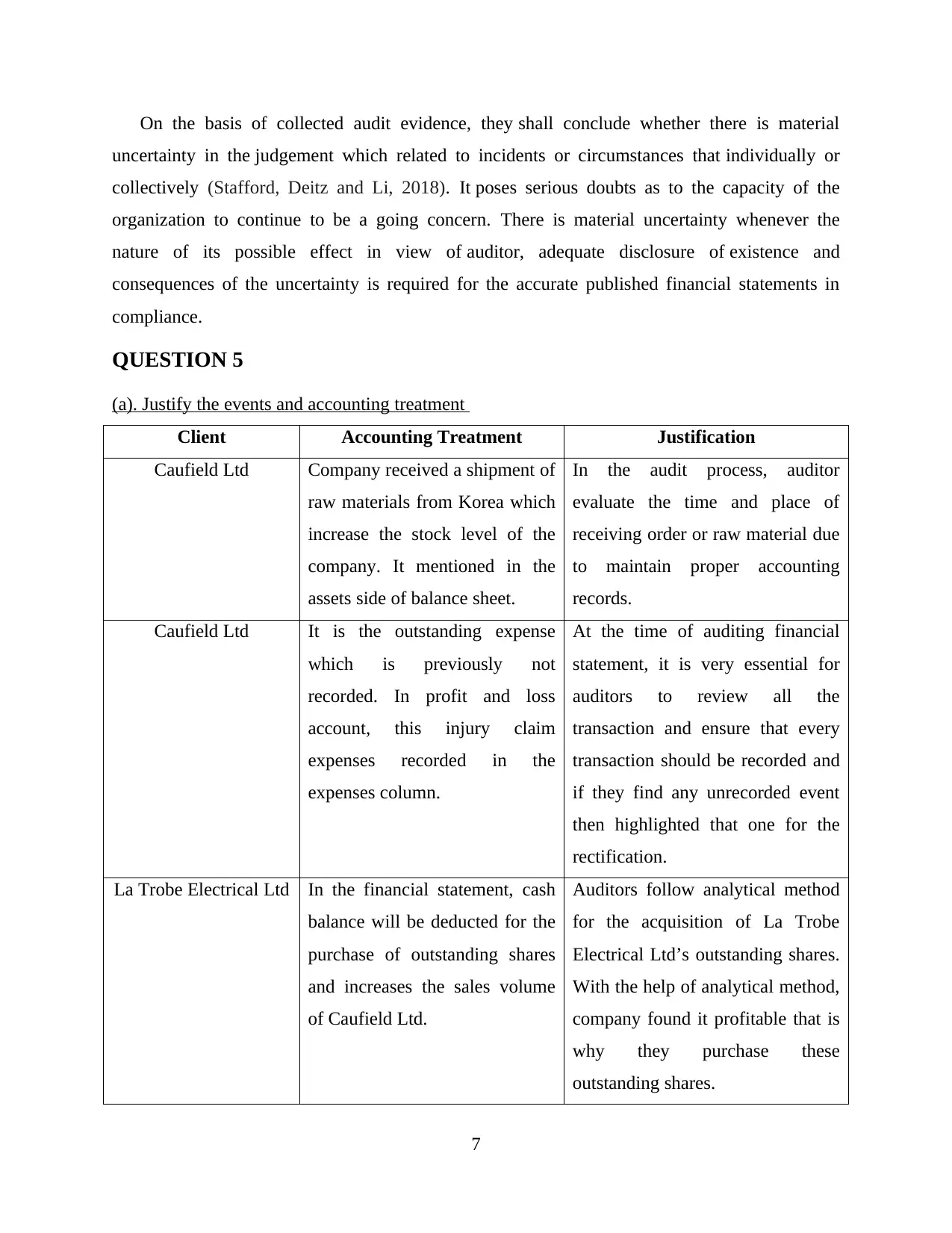
On the basis of collected audit evidence, they shall conclude whether there is material
uncertainty in the judgement which related to incidents or circumstances that individually or
collectively (Stafford, Deitz and Li, 2018). It poses serious doubts as to the capacity of the
organization to continue to be a going concern. There is material uncertainty whenever the
nature of its possible effect in view of auditor, adequate disclosure of existence and
consequences of the uncertainty is required for the accurate published financial statements in
compliance.
QUESTION 5
(a). Justify the events and accounting treatment
Client Accounting Treatment Justification
Caufield Ltd Company received a shipment of
raw materials from Korea which
increase the stock level of the
company. It mentioned in the
assets side of balance sheet.
In the audit process, auditor
evaluate the time and place of
receiving order or raw material due
to maintain proper accounting
records.
Caufield Ltd It is the outstanding expense
which is previously not
recorded. In profit and loss
account, this injury claim
expenses recorded in the
expenses column.
At the time of auditing financial
statement, it is very essential for
auditors to review all the
transaction and ensure that every
transaction should be recorded and
if they find any unrecorded event
then highlighted that one for the
rectification.
La Trobe Electrical Ltd In the financial statement, cash
balance will be deducted for the
purchase of outstanding shares
and increases the sales volume
of Caufield Ltd.
Auditors follow analytical method
for the acquisition of La Trobe
Electrical Ltd’s outstanding shares.
With the help of analytical method,
company found it profitable that is
why they purchase these
outstanding shares.
7
uncertainty in the judgement which related to incidents or circumstances that individually or
collectively (Stafford, Deitz and Li, 2018). It poses serious doubts as to the capacity of the
organization to continue to be a going concern. There is material uncertainty whenever the
nature of its possible effect in view of auditor, adequate disclosure of existence and
consequences of the uncertainty is required for the accurate published financial statements in
compliance.
QUESTION 5
(a). Justify the events and accounting treatment
Client Accounting Treatment Justification
Caufield Ltd Company received a shipment of
raw materials from Korea which
increase the stock level of the
company. It mentioned in the
assets side of balance sheet.
In the audit process, auditor
evaluate the time and place of
receiving order or raw material due
to maintain proper accounting
records.
Caufield Ltd It is the outstanding expense
which is previously not
recorded. In profit and loss
account, this injury claim
expenses recorded in the
expenses column.
At the time of auditing financial
statement, it is very essential for
auditors to review all the
transaction and ensure that every
transaction should be recorded and
if they find any unrecorded event
then highlighted that one for the
rectification.
La Trobe Electrical Ltd In the financial statement, cash
balance will be deducted for the
purchase of outstanding shares
and increases the sales volume
of Caufield Ltd.
Auditors follow analytical method
for the acquisition of La Trobe
Electrical Ltd’s outstanding shares.
With the help of analytical method,
company found it profitable that is
why they purchase these
outstanding shares.
7
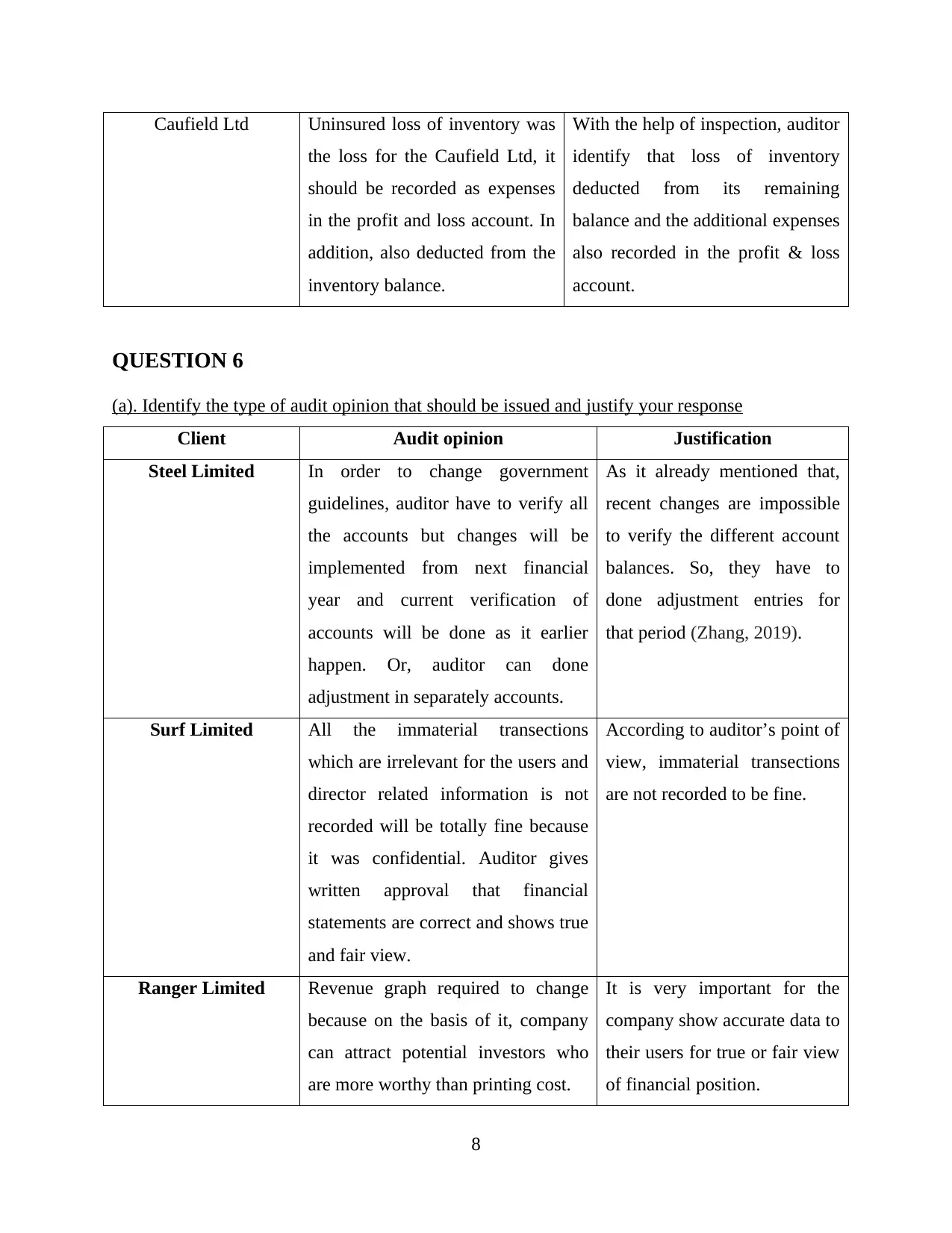
Caufield Ltd Uninsured loss of inventory was
the loss for the Caufield Ltd, it
should be recorded as expenses
in the profit and loss account. In
addition, also deducted from the
inventory balance.
With the help of inspection, auditor
identify that loss of inventory
deducted from its remaining
balance and the additional expenses
also recorded in the profit & loss
account.
QUESTION 6
(a). Identify the type of audit opinion that should be issued and justify your response
Client Audit opinion Justification
Steel Limited In order to change government
guidelines, auditor have to verify all
the accounts but changes will be
implemented from next financial
year and current verification of
accounts will be done as it earlier
happen. Or, auditor can done
adjustment in separately accounts.
As it already mentioned that,
recent changes are impossible
to verify the different account
balances. So, they have to
done adjustment entries for
that period (Zhang, 2019).
Surf Limited All the immaterial transections
which are irrelevant for the users and
director related information is not
recorded will be totally fine because
it was confidential. Auditor gives
written approval that financial
statements are correct and shows true
and fair view.
According to auditor’s point of
view, immaterial transections
are not recorded to be fine.
Ranger Limited Revenue graph required to change
because on the basis of it, company
can attract potential investors who
are more worthy than printing cost.
It is very important for the
company show accurate data to
their users for true or fair view
of financial position.
8
the loss for the Caufield Ltd, it
should be recorded as expenses
in the profit and loss account. In
addition, also deducted from the
inventory balance.
With the help of inspection, auditor
identify that loss of inventory
deducted from its remaining
balance and the additional expenses
also recorded in the profit & loss
account.
QUESTION 6
(a). Identify the type of audit opinion that should be issued and justify your response
Client Audit opinion Justification
Steel Limited In order to change government
guidelines, auditor have to verify all
the accounts but changes will be
implemented from next financial
year and current verification of
accounts will be done as it earlier
happen. Or, auditor can done
adjustment in separately accounts.
As it already mentioned that,
recent changes are impossible
to verify the different account
balances. So, they have to
done adjustment entries for
that period (Zhang, 2019).
Surf Limited All the immaterial transections
which are irrelevant for the users and
director related information is not
recorded will be totally fine because
it was confidential. Auditor gives
written approval that financial
statements are correct and shows true
and fair view.
According to auditor’s point of
view, immaterial transections
are not recorded to be fine.
Ranger Limited Revenue graph required to change
because on the basis of it, company
can attract potential investors who
are more worthy than printing cost.
It is very important for the
company show accurate data to
their users for true or fair view
of financial position.
8
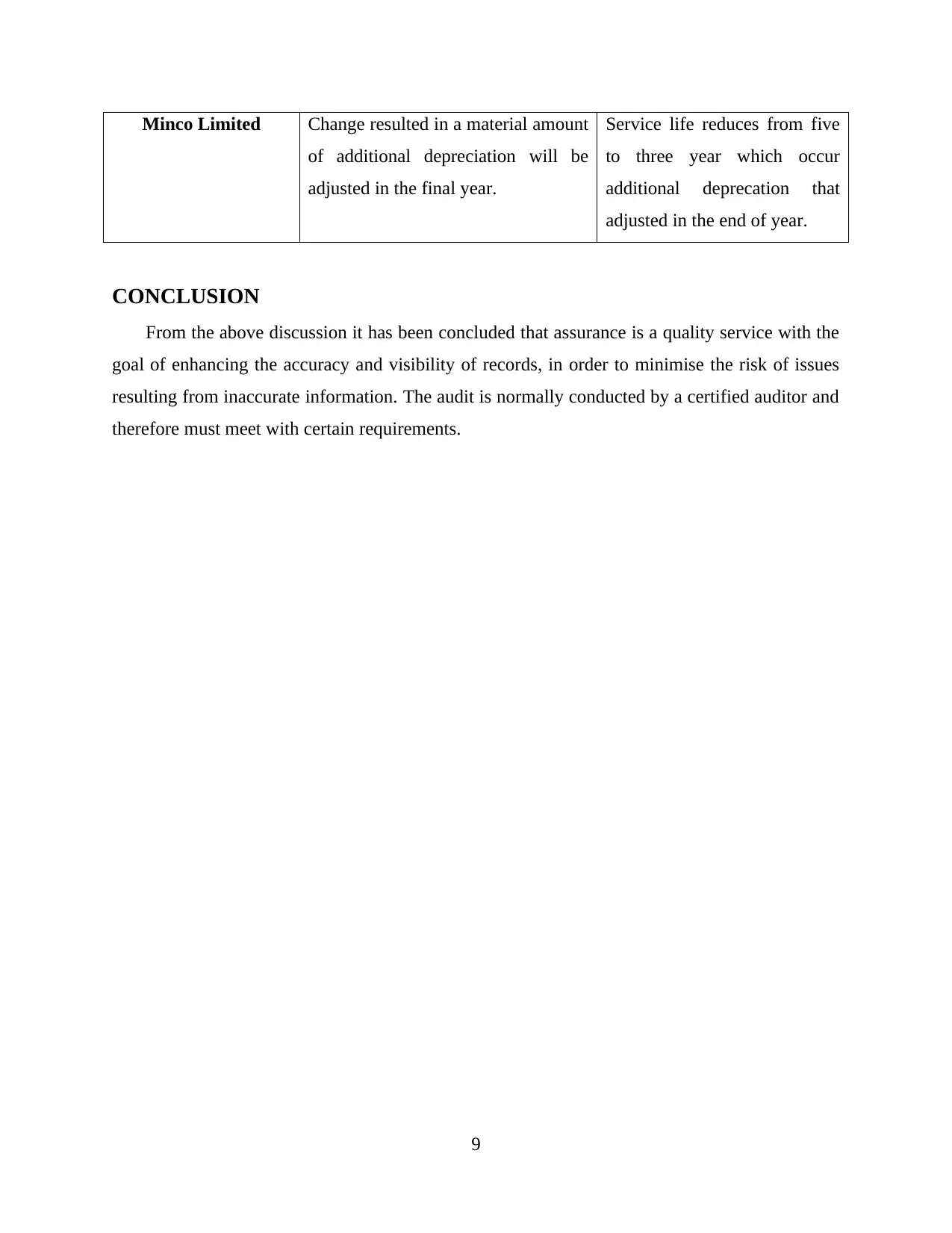
Minco Limited Change resulted in a material amount
of additional depreciation will be
adjusted in the final year.
Service life reduces from five
to three year which occur
additional deprecation that
adjusted in the end of year.
CONCLUSION
From the above discussion it has been concluded that assurance is a quality service with the
goal of enhancing the accuracy and visibility of records, in order to minimise the risk of issues
resulting from inaccurate information. The audit is normally conducted by a certified auditor and
therefore must meet with certain requirements.
9
of additional depreciation will be
adjusted in the final year.
Service life reduces from five
to three year which occur
additional deprecation that
adjusted in the end of year.
CONCLUSION
From the above discussion it has been concluded that assurance is a quality service with the
goal of enhancing the accuracy and visibility of records, in order to minimise the risk of issues
resulting from inaccurate information. The audit is normally conducted by a certified auditor and
therefore must meet with certain requirements.
9
Secure Best Marks with AI Grader
Need help grading? Try our AI Grader for instant feedback on your assignments.
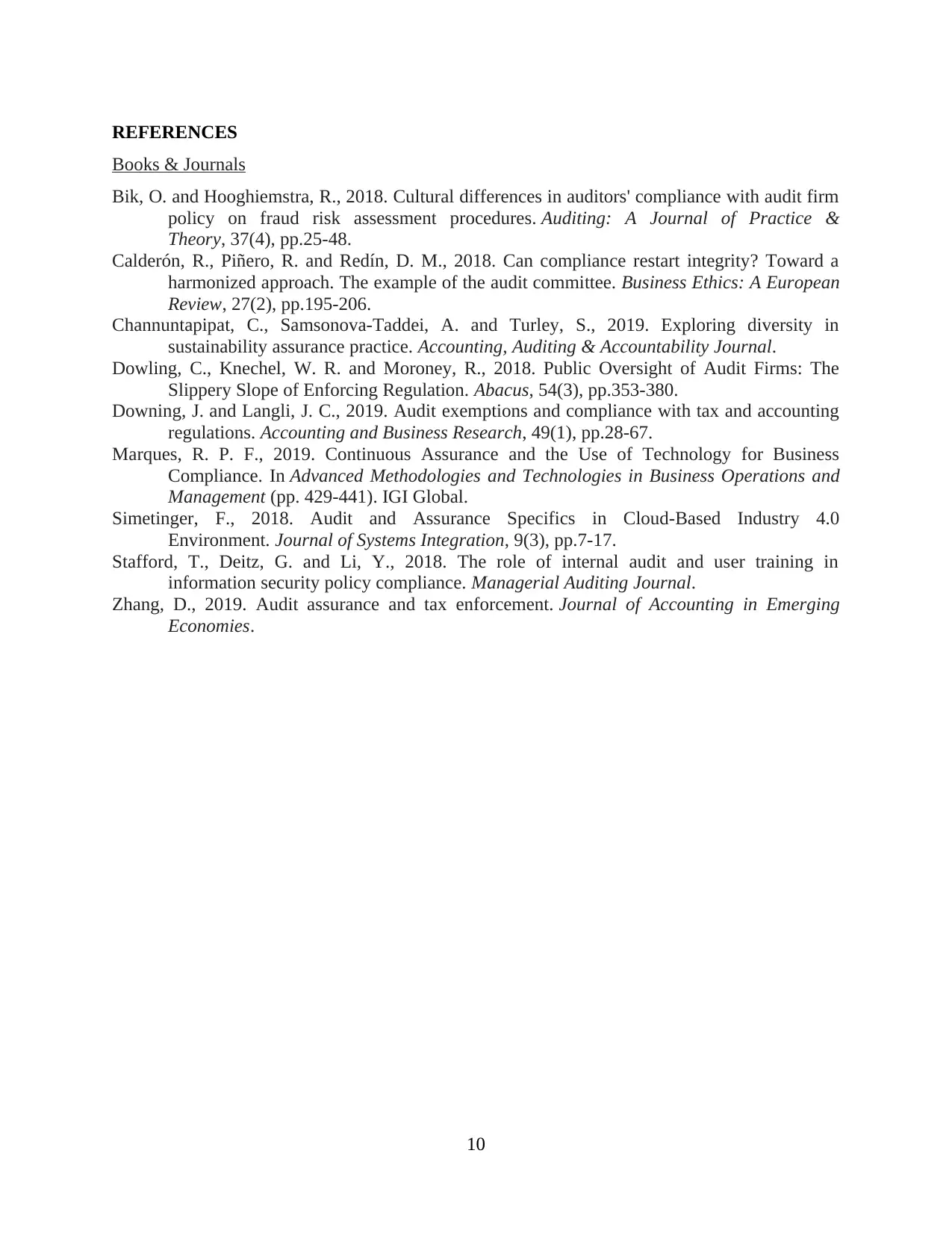
REFERENCES
Books & Journals
Bik, O. and Hooghiemstra, R., 2018. Cultural differences in auditors' compliance with audit firm
policy on fraud risk assessment procedures. Auditing: A Journal of Practice &
Theory, 37(4), pp.25-48.
Calderón, R., Piñero, R. and Redín, D. M., 2018. Can compliance restart integrity? Toward a
harmonized approach. The example of the audit committee. Business Ethics: A European
Review, 27(2), pp.195-206.
Channuntapipat, C., Samsonova-Taddei, A. and Turley, S., 2019. Exploring diversity in
sustainability assurance practice. Accounting, Auditing & Accountability Journal.
Dowling, C., Knechel, W. R. and Moroney, R., 2018. Public Oversight of Audit Firms: The
Slippery Slope of Enforcing Regulation. Abacus, 54(3), pp.353-380.
Downing, J. and Langli, J. C., 2019. Audit exemptions and compliance with tax and accounting
regulations. Accounting and Business Research, 49(1), pp.28-67.
Marques, R. P. F., 2019. Continuous Assurance and the Use of Technology for Business
Compliance. In Advanced Methodologies and Technologies in Business Operations and
Management (pp. 429-441). IGI Global.
Simetinger, F., 2018. Audit and Assurance Specifics in Cloud-Based Industry 4.0
Environment. Journal of Systems Integration, 9(3), pp.7-17.
Stafford, T., Deitz, G. and Li, Y., 2018. The role of internal audit and user training in
information security policy compliance. Managerial Auditing Journal.
Zhang, D., 2019. Audit assurance and tax enforcement. Journal of Accounting in Emerging
Economies.
10
Books & Journals
Bik, O. and Hooghiemstra, R., 2018. Cultural differences in auditors' compliance with audit firm
policy on fraud risk assessment procedures. Auditing: A Journal of Practice &
Theory, 37(4), pp.25-48.
Calderón, R., Piñero, R. and Redín, D. M., 2018. Can compliance restart integrity? Toward a
harmonized approach. The example of the audit committee. Business Ethics: A European
Review, 27(2), pp.195-206.
Channuntapipat, C., Samsonova-Taddei, A. and Turley, S., 2019. Exploring diversity in
sustainability assurance practice. Accounting, Auditing & Accountability Journal.
Dowling, C., Knechel, W. R. and Moroney, R., 2018. Public Oversight of Audit Firms: The
Slippery Slope of Enforcing Regulation. Abacus, 54(3), pp.353-380.
Downing, J. and Langli, J. C., 2019. Audit exemptions and compliance with tax and accounting
regulations. Accounting and Business Research, 49(1), pp.28-67.
Marques, R. P. F., 2019. Continuous Assurance and the Use of Technology for Business
Compliance. In Advanced Methodologies and Technologies in Business Operations and
Management (pp. 429-441). IGI Global.
Simetinger, F., 2018. Audit and Assurance Specifics in Cloud-Based Industry 4.0
Environment. Journal of Systems Integration, 9(3), pp.7-17.
Stafford, T., Deitz, G. and Li, Y., 2018. The role of internal audit and user training in
information security policy compliance. Managerial Auditing Journal.
Zhang, D., 2019. Audit assurance and tax enforcement. Journal of Accounting in Emerging
Economies.
10
1 out of 11
Related Documents
Your All-in-One AI-Powered Toolkit for Academic Success.
+13062052269
info@desklib.com
Available 24*7 on WhatsApp / Email
![[object Object]](/_next/static/media/star-bottom.7253800d.svg)
Unlock your academic potential
© 2024 | Zucol Services PVT LTD | All rights reserved.





